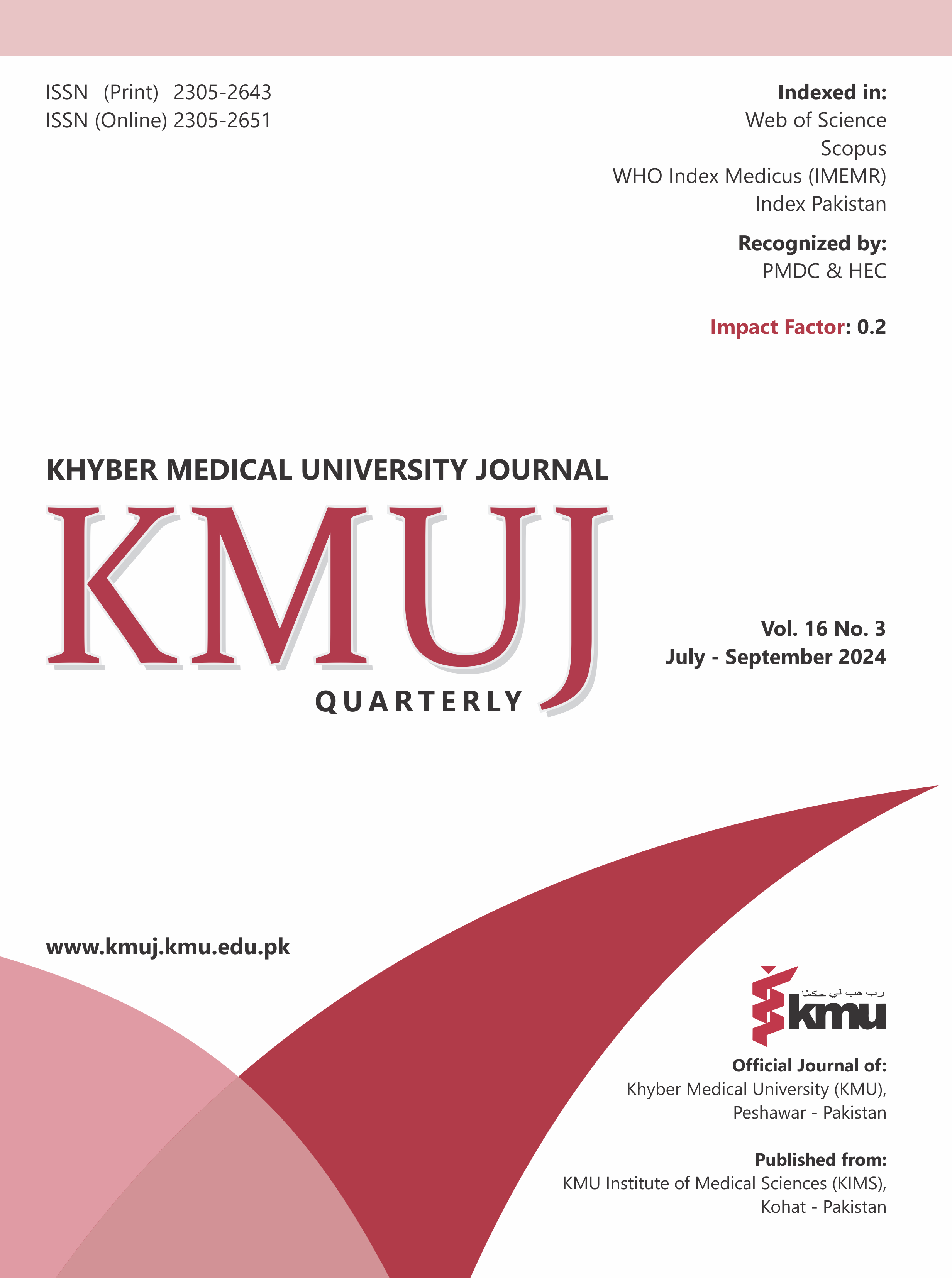A nonsense variant of reactivation gene-1 leads to Omenn syndrome in a Pakistani family
Main Article Content
Abstract
OBJECTIVE: To conduct clinical and genetic analysis in a patient with severe combined immunodeficiency disease (SCID).
METHODS: A 3.5-year-old female patient with chronic diarrhea, fever, and failure to thrive was examined at the Pakistan Institute of Medical Sciences, Islamabad. Ethical approval was obtained, and informed consent was secured for genetic studies. Flow cytometry was performed on blood samples to evaluate T, B, and NK cell concentrations. Genomic DNA was extracted from peripheral blood samples of the patient, her mother, and healthy siblings. Sanger sequencing of the RAG1 gene was conducted, followed by mutational analysis using BioEdit and bioinformatics tools for pathogenicity assessment.
RESULTS: The proband, the youngest girl born to first-cousin parents presented with intractable diarrhea with failure to thrive and skin and nappy rashes on clinical evaluation. The immunological assessment revealed total absence of B and T lymphocytes, normal NK cells (47% with 85% CD16 and CD56 respectively: No CD4, CD8 and CD19), and significant hypogammaglobulinemia (IgG;165 mg/dl, IgM; 9 mg/dl, IgA;8 mg/dl), while normal level of IgE (2 mg/dl). On the other hand, targeted Sanger sequencing of RAG1 exon 2 region revealed a new homozygous deleterious mutation (NM_000448.2: c.2876 G>A; p.Trp959*) in the RAG1 gene resulting in complete loss of function due to the production of truncated protein.
CONCLUSION: We identified a potentially pathogenic nonsense mutation in the RAG1 gene (c.2876 G>A; p.Trp959*) in a child with SCID. This finding emphasizes the significance of early detection for timely treatment and genetic counseling.
Article Details

This work is licensed under a Creative Commons Attribution 4.0 International License.
Work published in KMUJ is licensed under a
Creative Commons Attribution 4.0 License
Authors are permitted and encouraged to post their work online (e.g., in institutional repositories or on their website) prior to and during the submission process, as it can lead to productive exchanges, as well as earlier and greater citation of published work.
(e.g., in institutional repositories or on their website) prior to and during the submission process, as it can lead to productive exchanges, as well as earlier and greater citation of published work.
References
1. Shen J, Jiang L, Gao Y, Ou R, Yu S, Yang B et al. A novel RAG1 mutation in a compound heterozygous status in a child with Omenn syndrome. Front Genet 2019;10:913. https://doi.org/10.3389/fgene.2019.00913
2. Al-Herz W, Bousfiha A, Casanova JL, Chatila T, Cunningham-Rundles C, et al.. Primary immunodeficiency diseases: an update on the classification from the international union of immunological societies expert committee for primary immunodeficiency. Front Immunol 2014;5:78108. https://doi.org/10.3389/fimmu.2014.00162
3. Cossu F. Genetics of SCID. Ital J Pediatr 2010;36(1):76.
https://doi.org/10.1186/1824-7288-36-76
4. Ogando JCB, Gaytán AP, Becerra JCA, Cardona AÁ, Bezrodnik L, Borzutzky A, et al. Latin American consensus on the supportive management of patients with severe combined immunodeficiency. J Allergy Clin Immunol 2019;144(4):897-905. https://doi.org/10.1016/j.jaci.2019.08.002
5. Gennery A, Cant A. Diagnosis of severe combined immunodeficiency. J Clin Pathol 2001;54(3):191-5. https://doi.org/10.1136/jcp.54.3.191
6. Schatz DG, Swanson PC. V(D)J recombination: mechanisms of initiation. Annu Rev Genet 2011;45(1):167-202. https://doi.org/10.1146/annurev-genet-110410-132552
7. Tonegawa S. Somatic generation of antibody diversity. Nature 1983;302(5909):575-81. https://doi.org/10.1038/302575a0
8. Gellert M. V(D)J recombination: RAG proteins, repair factors, and regulation. Annu Rev Biochem 2002;71(1):101-32. https://doi:10.1146/annurev.biochem.71.090501.150203
9. Thwaites DT. Novel insights into the biochemical mechanisms of RAG1 and RAG2 using mutational approaches (Doctoral dissertation, University of Leeds);2019.
10. Notarangelo LD, Kim M-S, Walter JE, Lee YN. Human RAG mutations: biochemistry and clinical implications. Nat Rev Immunol 2016;16(4):234-46. https://doi:10.1038/nri.2016.28
11. Rieux-Laucat F, Bahadoran P, Brousse N, Selz F, Fischer A, Le Deist F, et al. Highly restricted human T cell repertoire in peripheral blood and tissue-infiltrating lymphocytes in Omenn’s syndrome. J Clin Invest 1998;102(2):312-21. https://doi:10.1172/JCI332
12. Villa A, Santagata S, Bozzi F, Giliani S, Frattini A, Imberti L, et al. Partial V(D)J recombination activity leads to Omenn syndrome. Cell 1998;93(5):885-96. https://doi:10.1016/s0092-8674(00)81448-8
13. Villa A, Sobacchi C, Notarangelo LD, Bozzi F, Abinun M, Abrahamsen TG, et al. V(D)J recombination defects in lymphocytes due to RAG mutations: severe immunodeficiency with a spectrum of clinical presentations. Blood 2001;97(1):81-8. https://doi:10.1182/blood.v97.1.81
14. Al-Mousa H, Al-Saud B. Primary immunodeficiency disease in highly consanguineous populations from Middle East and South Africa: Epidemiology, diagnosis and care. Front Immunol 2017;8:678. https://doi:10.3389/fimmu.2017.00678. eCollection2017
15. Raza SI, Nasser Dar R, Shah AA, Ahmad W. A novel homozygous nonsense mutation in the PVRL4 gene and expansion of clinical spectrum of EDSS1. Ann Hum Genet 2015;79(2):92-8.https://doi:10.1111/ahg.12094
16. Schatz DG. Transposition mediated by RAG1 and RAG2 and the evolution of the adaptive immune system. Immunol Res1999;19(2-3);169-82. https://doi:10.1007/BF02786485
17. McBlane JF, van Gent DC, Ramsden DA, Romeo C, Cuomo CA, Gellert M, et al. Cleavage at a V (D) J recombination signal requires only RAG1 and RAG2 proteins and occurs in two steps. Cell 1995;3;83(3):387-95. https://doi:10.1016/0092-8674(95)90116-7
18. Lawless D, Lango Allen H, Thaventhiran J, Hodel F, Anwar R, Fellay J et al. Predicting the Occurrence of Variants in RAG1 and RAG2. J Clin Immunol 2019;39(7);688-01. https://doi:10.1007/s10875-019-00670-z
19. Santagata S, Gomez CA, Sobacchi C, Bozzi F, Abinun M, Pasic S, et al. N-terminal RAG1 frameshift mutations in Omenn's syndrome: internal methionine usage leads to partial V (D) J recombination activity and reveals a fundamental role in vivo for the N-terminal domains. Proc Natl Acad Sci 2000;97(26);14572-7. https://doi:10.1073/pnas.97.26.14572
